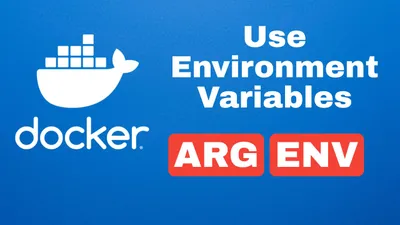How to Copy Multiple Files in One Layer Using a Dockerfile
Learn how to How to Copy Multiple Files in One Layer Using a Dockerfile to maker your work easier

Table of Contents
If you are working with Docker containers, you may find yourself needing to copy multiple files into a single layer using a Dockerfile. This can be a common task when setting up a container with all the necessary files and configurations. Fortunately, Docker provides a straightforward way to achieve this.
To copy multiple files in one layer using a Dockerfile, you can utilize the “COPY” command. This command allows you to copy files or directories from your build context into the container’s file system. By specifying multiple source files or directories and a destination directory in the container, you can copy all the required files in one go.
For example, you can use the following command in your Dockerfile to copy multiple files into a specific directory within the container:
COPY file1.txt file2.txt /app/files/In this case, “file1.txt” and “file2.txt” from your build context will be copied into the “/app/files/” directory within the container. You can add more files or directories as needed, separating them with spaces.
Copying multiple files in one layer using a Dockerfile can save you time and effort while building your containers. This method ensures that all the necessary files are available within the container, simplifying your deployment process.
Some other docker articles that can help you in your docker journey:
- Add Users to a Docker Container
- Install Docker & Docker-compose for Ubuntu ARM
- Redirect Docker Logs to a Single File
- Environment Variables ARG and ENV in Docker
Using COPY instruction to copy files in a Dockerfile
In a Dockerfile, the COPY instruction is used to copy files from the host machine to the container’s file system. This instruction allows you to include multiple files in a single layer, which can help improve the build time and efficiency of your Docker image.
Here is how you can use the COPY instruction to copy files in a Dockerfile:
-
Syntax: The syntax for the COPY instruction is as follows:
COPY <src> <dest><src>: Specifies the source file or directory on the host machine.<dest>: Indicates the destination directory in the container’s file system.
-
Copying Files: To copy a single file, you can specify the file’s path as the source and provide the destination directory in the container’s file system.
COPY app.js /app/This command will copy the
app.jsfile from the host machine to the/app/directory inside the container. -
Copying Directories: If you want to copy an entire directory, you can specify the directory’s path as the source and provide the destination directory.
COPY src/ /app/src/This command will copy the
srcdirectory and all its contents to the/app/src/directory inside the container. -
Wildcard Patterns: The COPY instruction also supports wildcard patterns, allowing you to copy multiple files matching a certain pattern.
COPY *.txt /app/This command will copy all the text files in the current directory on the host machine to the
/app/directory inside the container. -
Copying Multiple Files: To copy multiple files, you can specify each file individually, separating them with a space.
COPY file1.txt file2.txt /app/This command will copy both
file1.txtandfile2.txtto the/app/directory inside the container.
Using the COPY instruction in your Dockerfile allows you to easily include the necessary files in your container at build time. By efficiently copying multiple files in a single layer, you can enhance the performance of your Docker image and streamline the containerization process.
Including multiple source files in the COPY instruction
The COPY instruction in a Dockerfile is used to copy files from the host machine to the Docker image. It allows you to include multiple source files in a single instruction, which can be beneficial when you need to copy multiple files efficiently. Here’s how you can do it:
-
Specify the source files: Begin by listing all the source files you want to copy inside the Dockerfile. These files can be located in the same directory or different directories.
-
Use wildcards or glob patterns: Docker supports using wildcards or glob patterns to specify the source files. This allows you to copy multiple files that match a certain pattern, reducing the number of COPY instructions needed. For example, you can use
*to match all files, or*.txtto match all text files. -
Specify the destination directory: After specifying the source files, you need to mention the destination directory inside the Docker image where these files will be copied. It’s important to ensure that the destination directory exists or create it if necessary.
Here’s an example of how the COPY instruction can be used to copy multiple source files:
COPY file1.txt file2.txt /app/
COPY *.csv /data/
COPY src/. /code/In this example, we are copying file1.txt and file2.txt to the /app/ directory, all CSV files in the current directory to the /data/ directory, and all files and directories inside the src/ directory to the /code/ directory.
By including multiple source files in a single COPY instruction, you can minimize the number of instructions in your Dockerfile and make the image build process more efficient.
Remember to also consider the order in which you list the source files, as the COPY instruction will preserve that order when copying them into the image.
Using wildcards to copy multiple files in a single layer
When building Docker images, it is common to include multiple files in a single layer to optimize the image layering process. One way to achieve this is by using wildcards in your Dockerfile’s COPY instruction. Wildcards allow you to match patterns and copy multiple files at once, reducing the number of individual COPY instructions needed.
Here’s a breakdown of how you can use wildcards effectively to copy multiple files in a Dockerfile:
-
Understand wildcard patterns: Wildcard patterns use special characters to match multiple files or directories. The two most commonly used wildcards are
*and?. The*character matches any sequence of characters, while the?character matches any single character. For example,*.txtmatches all files with the.txtextension, andfile?.txtmatches any file with the name “file” followed by any single character and then the.txtextension. -
Specify the source and destination in the COPY instruction: In your Dockerfile, use the
COPYinstruction to copy files from the build context (source) to the image (destination). By specifying wildcards in the source path, you can copy multiple files that match the pattern to a single directory in the destination path. For example,COPY src/*.txt dest/would copy all files with the.txtextension from thesrcdirectory to thedestdirectory in the image. -
Consider directory structures: When using wildcards, be mindful of the directory structures in your build context. You can use wildcards to match files in specific directories or nested subdirectories. For instance,
COPY src/**/*.txt dest/would recursively copy all files with the.txtextension from any subdirectory within thesrcdirectory to thedestdirectory in the image.
Using wildcards in your Dockerfile’s COPY instruction can greatly simplify the process of copying multiple files in a single layer. It allows you to leverage the power of pattern matching to efficiently include desired files in your image. Remember to experiment and test your Dockerfile to ensure that the expected files are being copied correctly.
Here’s a table summarizing the usage of wildcards for convenience:
| Wildcard | Description |
|---|---|
* | Matches any sequence of characters |
? | Matches any single character |
** | Matches any directory and its subdirectories |
{} | Matches specific patterns within a set of alternatives. (e.g., {*.txt, *.md} matches all files with .txt or .md extension) |
With this knowledge, you can make your Dockerfile more concise and efficient by using wildcards to copy multiple files in a single layer. Happy containerizing!
Organizing files in separate directories for better readability
When working with a Dockerfile, it’s important to maintain a clear and organized file structure to ensure better readability of your project. In this section, we will explore how to organize files in separate directories, making it easier to manage and understand your Dockerfiles.
1. Create a directory structure: Start by creating a dedicated directory for your Docker project. Within this directory, you can further organize your files into separate folders based on their purpose or functionality. For example, you can have separate directories for source code, configurations, and any other related files.
2. Store related files together: Group all the relevant files for a particular function or component within their respective directories. This approach aids in quickly identifying and locating the necessary files when working on different parts of your project.
3. Utilize subdirectories: If your project has multiple layers or components, consider using subdirectories within each component directory. This can help maintain a hierarchical structure and further improve the readability of your Dockerfile.
4. Avoid clutter: Keep your directories clean and avoid including unnecessary files or directories that do not directly contribute to your Dockerfile. Excessive clutter can make it challenging to navigate through your project and hinder readability.
5. Document your directory structure: Make sure to include a README.md file within your project’s main directory, detailing the purpose and organization of each directory. This helps other developers understand the layout of your project quickly.
By organizing your files in separate directories, you give your Dockerfile a clear and concise structure, making it easier to understand and maintain. Remember, a well-organized project enhances collaboration and allows for smoother development processes.
Best practices for efficient file copying in a Dockerfile
When it comes to copying multiple files in one layer using a Dockerfile, there are a few best practices that can help ensure efficiency and smooth operation. Let’s dive into some key tips:
1. Group related files together
- To minimize layer size and optimize build time, it’s advisable to group files that are related to each other and likely to change together into a single directory.
- This approach reduces the number of separate copy instructions in the Dockerfile.
2. Leverage .dockerignore file
- Use a
.dockerignorefile to exclude unnecessary files and directories from being copied into the Docker image. - Avoid copying unnecessary files that are not required for the application to run correctly.
- This reduces the build context and significantly improves the build speed.
3. Order files based on frequency of change
- Arrange the files in the Dockerfile’s COPY instruction according to their frequency of change.
- Files that change less frequently should be placed before files that change more often.
- This way, you can take advantage of Docker’s layer caching mechanism and avoid unnecessary rebuilds.
4. Use wildcards cautiously
- When copying files, be cautious when using wildcards (e.g.,
*or**) as it may unintentionally include unwanted files or directories. - Explicitly specifying file paths is generally safer and more predictable.
5. Consider volume mounting for development
- In development environments, rather than copying files into the image, consider using volume mounting.
- Volume mounting allows for live code changes, enabling faster development cycles without the need for rebuilding the Docker image.
By following these best practices, you can optimize the file copying process in your Dockerfile, resulting in faster and more efficient builds. Remember, keep your layers small, exclude unnecessary files, and order the files strategically to take full advantage of Docker’s caching capabilities. Happy and efficient Dockerfile building!
Conclusion
In this article, we have explored the process of copying multiple files in one layer using a Dockerfile. By implementing this technique, you can efficiently manage and organize your files within a Docker image.
Here’s a quick recap of the steps involved in achieving this:
- Begin by creating a Dockerfile in your project directory.
- Use the
COPYinstruction to copy multiple files from your local directory to the desired location within the Docker image. - Specify the source files and the destination directory in the Dockerfile.
- Repeat the
COPYinstruction as needed to copy all the required files. - Build your Docker image using the
docker buildcommand, providing the path to your Dockerfile. - Test the resulting image to ensure that the files have been copied correctly.
Using this approach, you can streamline the process of copying multiple files into a Docker image, making your containerized applications more efficient and easier to distribute.
Remember, Docker provides a powerful platform for building and deploying applications, and knowing how to effectively manage files is an essential skill. By mastering techniques like copying multiple files in one layer, you can leverage the full potential of Docker to enhance your development workflow.
If you have any questions or need further assistance, feel free to reach out to the Docker community or consult the official Docker documentation. Happy coding!
Related Posts

How to Redirect Docker Logs to a Single File
Learn how to Redirect Docker Logs to a Single File to make your work easier

How to Use Environment Variables ARG and ENV in Docker, Dockerfile or Docker Compose
Learn how to use environments variables ARG and ENV into Docker command, Dockerfile or Docker Compose

How To Clean All Docker Images With Disks and Everything
Learn how to declutter your Docker environment. Our guide shows you how to remove images, containers, volumes, and networks, freeing up valuable disk space. Follow step-by-step instructions to start fresh with Docker.